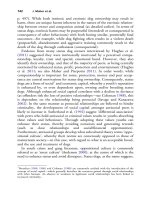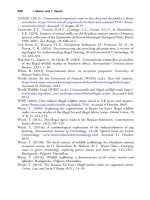The palgrave international handbook of a 280
Bạn đang xem bản rút gọn của tài liệu. Xem và tải ngay bản đầy đủ của tài liệu tại đây (38.06 KB, 1 trang )
Animal Racing: Shifting Codes of Canadian Social Tolerance
277
2015). A so-called ‘Racehorse Memorial Wall Worldwide’ is also illuminating (Racehorse Memorial 2016). Needless to say, none of these sites cast a
flattering light on the question of racing horses at high risk, though many
of their findings remain vague and questionable.
These measurement problems, notwithstanding, there are strong indicators that chuckwagon racing and equine health are not natural partners.
According to the VHS (2011), over 50 chuckwagon horses were fatally
injured or had to be euthanized between 1986 and 2011. As noted generally
by McBane and Douglas-Coope (2005), and more specifically by the CHS
(2011), horses involved in, and being trained for rodeo, face regular physical
discomfort and mental distress. Accidents, injuries and fatalities are simply a
routine feature of the annual chuckwagon races at the Calgary Stampede.
More troubling is the fact that unknown numbers of injuries and fatalities
take place behind the scenes in preparation for competition—that is, in
situations where the public normally has no access and where injury tolls
go unreported. According to both media reports (for example, Ban
Chuckwagon Racing 2013) and the aforementioned VHS (2011) report, in
2005, at least nine horses died while being transported to Stampede Park. In
2006, two horses died as a result of chuckwagon races, in 2007 three died,
and in 2008, one more horse died. In 2009, two horses died, and in 2010 six
horses died (four in chuckwagon racing competitions, and the other two in
other rodeo events). Despite well-publicized rule changes to chuckwagon
racing in 2011, intended to facilitate enhanced animal welfare on the track,
two more horses perished during the 2011 competition, and in 2012, three
more died. One horse died in both 2013 and 2014.4 Most recently, four
more horse deaths in 2015 led the Stampede to finally acknowledge its
embarrassing safety record (“Calgary Stampede ‘Not Proud’ of its Animal
safety Record as Fourth Horse Dies in Chuckwagon Races,” National Post
2015). Almost all of these deaths took place on the chuckwagon track, several
due to driver error. The GMC Rangeland Derby is perhaps suitably known
as the ‘Half Mile of Hell’.
In some cases horses involved in crashes have had to be euthanized on site
in front of spectators before being removed from the track using heavy
machinery. However, other instances of abuse related to overtraining or
overuse are far removed from the cameras and glare of the public eye
(Gerber and Young 2013, p. 537). As viewed through the lens of symbolic
4
/>









